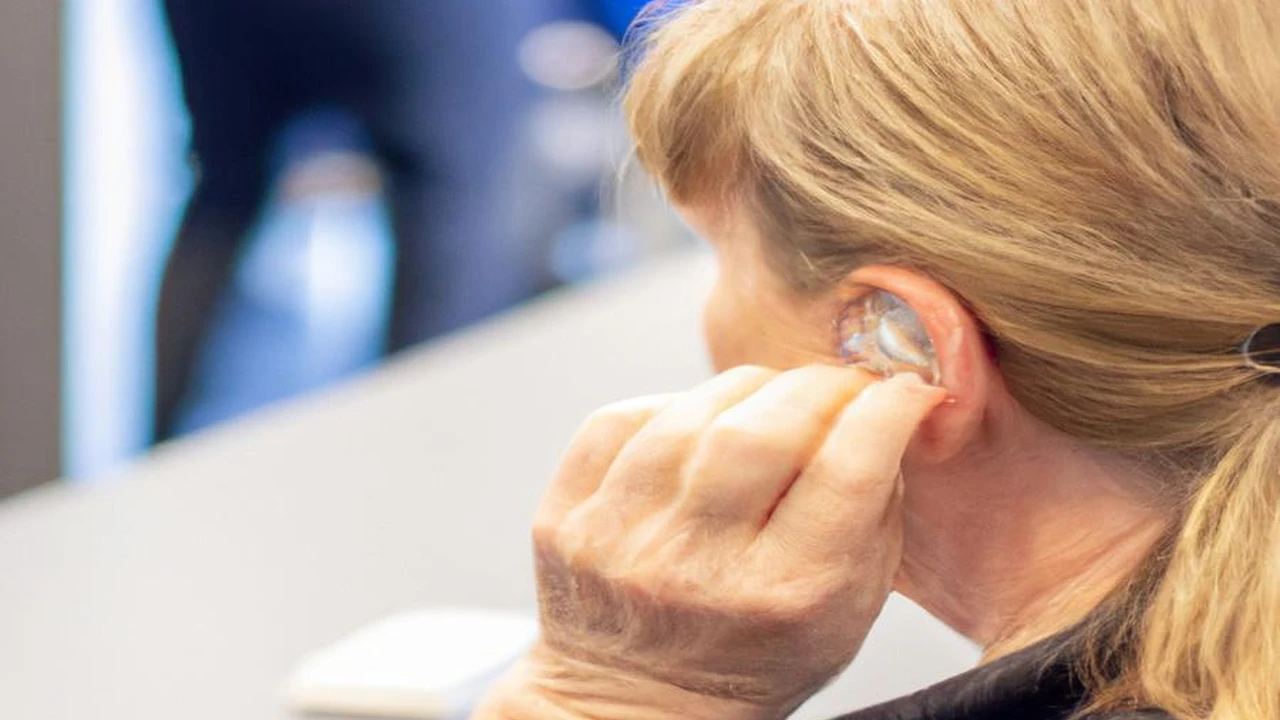Best Hearing Aids For Phone Calls and Streaming
Find the best hearing aids optimized for phone calls and audio streaming. Compare models with excellent Bluetooth connectivity and clear sound transmission.

Best Hearing Aids For Phone Calls and Streaming
Why Phone Calls and Streaming Matter for Hearing Aid Users
Let's face it, in today's world, our smartphones are practically extensions of ourselves. We use them for everything: talking to loved ones, catching up on podcasts, listening to music, watching videos, and even navigating our daily lives. For people with hearing loss, this reliance on smartphones can sometimes be a bit of a challenge. Traditional phone calls can be difficult to understand, and enjoying audio content often means cranking up the volume to uncomfortable levels or missing out entirely. That's where modern hearing aids with advanced connectivity come in. They're designed to seamlessly integrate with your digital life, making phone calls clearer and streaming audio a joy.
Imagine being able to answer a call directly through your hearing aids, with the sound going straight into your ears, bypassing background noise. Or picture yourself listening to your favorite music with crystal-clear fidelity, without needing headphones or struggling to hear through external speakers. This isn't just about convenience; it's about improving communication, enhancing entertainment, and ultimately, boosting your overall quality of life. When your hearing aids can connect effortlessly to your phone, tablet, or even your TV, you're more connected to the world around you.
Key Features to Look For in Streaming Hearing Aids
When you're on the hunt for hearing aids that excel at phone calls and streaming, there are a few crucial features you'll want to prioritize. These aren't just fancy add-ons; they're the core technologies that make a real difference in your daily listening experience.
Bluetooth Connectivity and Compatibility
Bluetooth is the star of the show here. Most modern streaming hearing aids use Bluetooth Low Energy (BLE) for efficient and stable connections. You'll want to check if the hearing aids are 'Made for iPhone' (MFi) or 'Made for Android' (AFA). MFi hearing aids offer direct streaming to Apple devices without an intermediary device, which is super convenient. For Android users, AFA hearing aids provide similar direct streaming capabilities, though compatibility can vary more between phone models. Some hearing aids might require a separate streaming accessory (often called a 'streamer' or 'clip') to connect to certain phones or older devices. While these accessories add an extra step, they can significantly improve connectivity and sound quality for some users.
Direct Audio Streaming Capabilities
Direct audio streaming means the sound from your phone or other connected device goes straight into your hearing aids. This is a game-changer because it eliminates the need for headphones and ensures the audio is delivered directly to your ears, often processed to compensate for your specific hearing loss. This results in much clearer sound, whether you're on a call, listening to music, or watching a video. Look for hearing aids that offer robust direct streaming for both phone calls and general audio.
Hands Free Calling Functionality
This is a big one for convenience. Hands-free calling means you can answer and conduct phone conversations without even touching your phone. Your hearing aids act as both the receiver and the microphone. This is incredibly useful when you're driving, cooking, or simply don't want to hold your phone to your ear. Not all streaming hearing aids offer true hands-free calling, so if this is important to you, make sure to confirm this feature.
Sound Quality and Clarity for Calls and Music
Of course, connectivity is only half the battle; the sound quality needs to be excellent too. Look for hearing aids that boast advanced sound processing, noise reduction algorithms, and wide frequency response. For phone calls, this means voices sound natural and clear, even in noisy environments. For music and other audio, you want a rich, full sound that allows you to appreciate all the nuances. Some hearing aids even have dedicated streaming programs that optimize the sound for different types of audio content.
Battery Life with Streaming Usage
Streaming audio uses more power than regular hearing aid operation. Consider the battery life, especially if you plan to stream frequently. Rechargeable hearing aids are often a great choice here, as you can simply pop them in their charger overnight. If you opt for disposable batteries, make sure you're aware of how often you'll need to change them, especially with heavy streaming use.
Top Hearing Aid Models for Phone Calls and Streaming
Alright, let's dive into some specific models that consistently receive high marks for their phone call and streaming capabilities. Keep in mind that technology evolves rapidly, so always check with an audiologist for the very latest models and features.
Phonak Paradise and Lumity Series Excellent Universal Connectivity
Phonak has long been a leader in universal Bluetooth connectivity, and their Paradise and newer Lumity platforms continue this tradition. These hearing aids are renowned for their ability to connect directly to virtually any Bluetooth-enabled device, including both iOS and Android phones, tablets, and even some computers. This means true hands-free calling for most users, where the hearing aids act as both microphone and speaker. The sound quality for streaming music and podcasts is also excellent, with a rich and immersive experience. They offer multiple simultaneous Bluetooth connections, so you can switch between your phone and tablet easily. Prices for Phonak Lumity models typically range from $2,500 to $7,000 per pair, depending on the technology level and provider.
Oticon More and Real Series Superior Sound Processing
Oticon's More and Real series are fantastic for streaming, especially for iPhone users (MFi). While they don't always offer hands-free calling directly from the hearing aids for all Android phones without an accessory, their sound processing for streamed audio is exceptional. Oticon's BrainHearing technology aims to give your brain access to the full soundscape, which translates well to streamed content, making it sound very natural and clear. They also have a TV Adapter for seamless streaming from your television. Prices for Oticon Real models generally fall between $2,000 and $6,500 per pair.
Resound ONE and OMNIA Series Personalized Streaming Experience
Resound's ONE and OMNIA hearing aids offer excellent direct streaming capabilities for both MFi and AFA devices. What sets them apart is their M&RIE (Microphone & Receiver-In-Ear) design, which places a microphone in the ear canal, leveraging your ear's natural acoustics for a more natural sound experience, including streamed audio. They also offer hands-free calling for compatible devices. Resound's accompanying app provides extensive personalization options for streaming, allowing you to fine-tune the sound to your preferences. Expect to pay between $2,200 and $6,800 per pair for Resound OMNIA.
Starkey Evolv AI and Genesis AI Series Smart Features and Connectivity
Starkey's Evolv AI and newer Genesis AI hearing aids are packed with smart features, and their streaming capabilities are top-notch. They offer direct streaming for both MFi and AFA devices, along with hands-free calling. Starkey's Edge Mode technology uses AI to optimize sound in challenging listening environments, which can be beneficial during phone calls in noisy places. They also have a range of accessories, including a TV streamer and a remote microphone, to enhance your streaming experience. Prices for Starkey Genesis AI typically range from $2,800 to $7,500 per pair.
Widex Moment and PureSound Technology for Clear Audio
Widex Moment hearing aids are known for their PureSound technology, which aims to eliminate processing delays, resulting in a more natural and clear sound. This translates beautifully to streamed audio, making music and voices sound incredibly authentic. They offer direct streaming for MFi devices and often require an accessory for full Android compatibility and hands-free calling. If natural sound quality is your absolute top priority for streaming, Widex is definitely worth considering. Widex Moment prices usually range from $2,300 to $6,900 per pair.
Comparing Streaming Performance Across Brands
While all the brands mentioned above offer excellent streaming, there are subtle differences that might make one a better fit for you than another. It often comes down to your specific phone, your listening preferences, and whether hands-free calling is a must-have.
Universal Connectivity vs Device Specific Optimization
Phonak stands out for its truly universal Bluetooth connectivity, making it a great choice if you frequently switch between different brands of phones or other devices. Other brands, while offering excellent streaming, might be more optimized for specific ecosystems (like MFi for Apple users) or require an accessory for broader compatibility. If you're an Android user, it's especially important to check the specific model's compatibility with your phone.
Hands Free Calling Implementation
Phonak, Resound, and Starkey generally offer true hands-free calling where the hearing aids act as both microphone and speaker. Oticon and Widex, while offering excellent streaming, might require you to speak into your phone's microphone for some Android devices, or use a separate accessory for full hands-free functionality. If you're constantly on the phone and need to keep your hands free, this distinction is important.
Audio Quality for Music and Podcasts
For pure audio fidelity, Widex with its PureSound technology often gets high praise for its natural and uncolored sound. Oticon's BrainHearing approach also delivers a very rich and detailed soundscape. Phonak and Resound also offer excellent music streaming, often with customizable programs to enhance the experience. It's highly recommended to try streaming your favorite music or podcast during a demo to see which sounds best to your ears.
Accessories for Enhanced Streaming
Many brands offer additional accessories that can enhance your streaming experience. TV streamers, for example, send audio directly from your television to your hearing aids, eliminating the need for loud volumes or external speakers. Remote microphones can be incredibly useful in noisy environments, allowing you to hear a speaker's voice directly in your hearing aids. Consider if these accessories would add value to your daily life.
Real World Scenarios How Streaming Hearing Aids Help
Let's look at some everyday situations where hearing aids with great streaming capabilities can truly shine.
Seamless Phone Conversations Anywhere
Imagine you're at a busy coffee shop, and your phone rings. Instead of struggling to hear the person on the other end over the clatter of cups and chatter, the call streams directly into your hearing aids. The background noise is reduced, and the voice is clear and distinct. You can have a natural conversation without missing a beat, even hands-free if your hearing aids support it. This is a huge confidence booster and makes staying connected so much easier.
Enjoying Music and Podcasts On The Go
Whether you're commuting, exercising, or just relaxing, being able to stream your favorite music or podcasts directly to your hearing aids is a game-changer. No more fumbling with headphones that might interfere with your hearing aids or cause feedback. The audio is delivered directly to your ears, optimized for your hearing loss, providing a rich and immersive listening experience that you might have thought was out of reach.
Enhanced TV Viewing Experience
With a TV streamer accessory, you can send the audio from your television directly to your hearing aids. This means you can hear dialogue and sound effects clearly, without having to turn up the TV volume to levels that might bother others in the room. It's a more personalized and enjoyable viewing experience for everyone.
Better Understanding in Online Meetings and Video Calls
In our increasingly digital world, online meetings and video calls are commonplace. When the audio from these calls streams directly to your hearing aids, you'll find it much easier to follow conversations, understand different speakers, and participate actively. This can significantly improve your professional and personal interactions.
Using Navigation Apps and Voice Assistants
Getting directions from your phone's navigation app or asking your voice assistant a question becomes much clearer when the audio cues are streamed directly to your hearing aids. You won't miss important instructions, and you can interact with your devices more naturally and effectively.
Tips for Maximizing Your Streaming Experience
Once you have your streaming-capable hearing aids, here are a few tips to get the most out of them:
Regular Software Updates for Optimal Performance
Just like your smartphone, your hearing aids often receive software updates. These updates can improve connectivity, enhance sound quality, and even add new features. Make sure to keep your hearing aids' software up to date, usually through the manufacturer's app or with the help of your audiologist.
Understanding Your Hearing Aid App Settings
Most modern hearing aids come with a companion smartphone app. Spend some time exploring the app's settings. You can often adjust volume, change programs, and even fine-tune the sound for streaming. Some apps allow you to create custom programs for different streaming scenarios, like a 'music' program or a 'podcast' program.
Managing Battery Life Effectively
Streaming uses more battery power. If you're going to be streaming for extended periods, make sure your hearing aids are fully charged (if rechargeable) or that you have spare batteries on hand (if disposable). Consider carrying a portable charging case for rechargeable models for extra peace of mind.
Troubleshooting Common Connectivity Issues
Sometimes, Bluetooth connections can be a bit finicky. If you're having trouble connecting, try turning your phone's Bluetooth off and on again, or restarting your hearing aids. Make sure your hearing aids are within range of your device. If problems persist, your audiologist can help diagnose and resolve connectivity issues.
Working with Your Audiologist for Customization
Your audiologist is your best resource for optimizing your streaming experience. They can adjust your hearing aid settings to ensure the streamed audio sounds its best for your specific hearing loss. Don't hesitate to discuss any challenges or preferences you have regarding phone calls and streaming with them.
The Future of Hearing Aid Streaming and Connectivity
The world of hearing aid technology is constantly evolving, and connectivity is a major area of innovation. We're already seeing exciting developments, and more are on the horizon.
LE Audio and Enhanced Bluetooth Standards
The new Bluetooth LE Audio standard promises even better sound quality, lower power consumption, and the ability to broadcast audio to multiple devices simultaneously. This could mean even longer battery life for streaming and the potential for public audio broadcasts (like in airports or museums) directly to your hearing aids. This is a significant step forward for accessibility.
Integration with Smart Home Devices and AI
Imagine your hearing aids seamlessly connecting with your smart home devices. You could get notifications from your doorbell, smoke detector, or even your smart oven directly in your ears. AI integration will likely lead to even more personalized and adaptive streaming experiences, with hearing aids automatically optimizing sound based on your environment and preferences.
Improved Hands Free Communication Across All Devices
As technology advances, we can expect more universal and robust hands-free calling capabilities across all smartphone platforms, eliminating the need for separate accessories or specific phone models. This will make communication even more effortless and natural for everyone.
Choosing the right hearing aids for phone calls and streaming can truly transform your daily life. By focusing on models with strong Bluetooth connectivity, excellent sound quality, and features like hands-free calling, you can stay connected, entertained, and engaged with the world around you like never before. Remember to work closely with your audiologist to find the perfect fit for your unique needs and lifestyle.
:max_bytes(150000):strip_icc()/277019-baked-pork-chops-with-cream-of-mushroom-soup-DDMFS-beauty-4x3-BG-7505-5762b731cf30447d9cbbbbbf387beafa.jpg)






